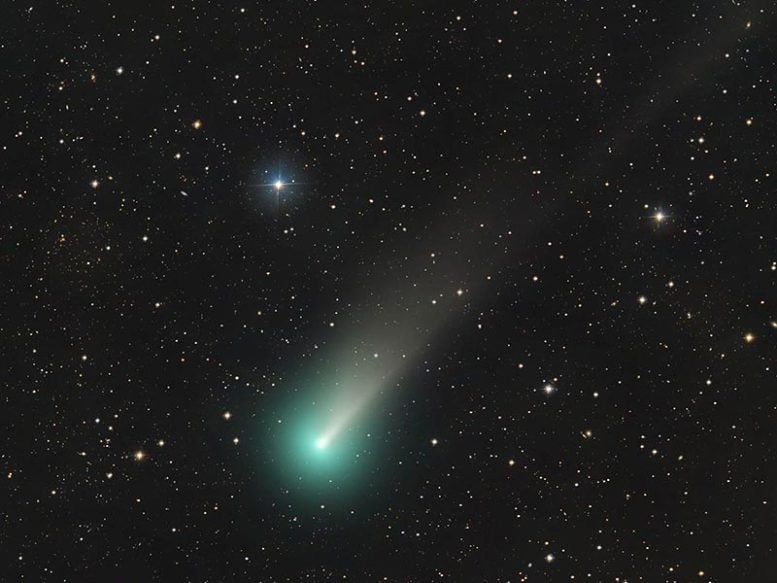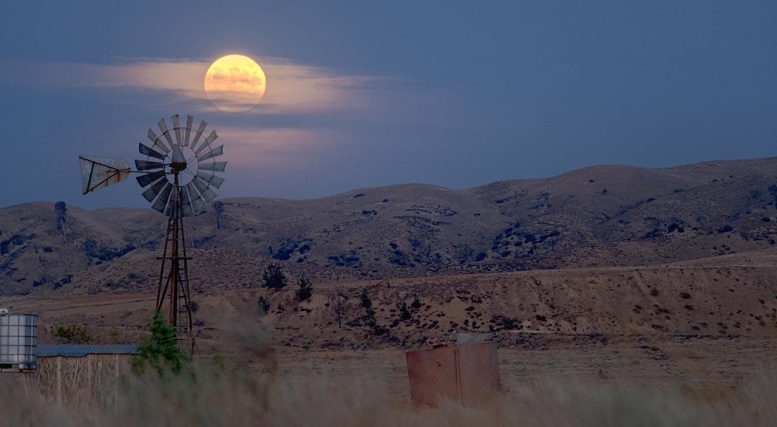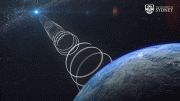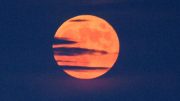The next full Moon is a near-total lunar eclipse, the Beaver, Frost/Frosty, or Snow Moon; Kartik Purnima, the full Moon of the Festivals of Karthika Deepam, Karthikai Vilakkidu, Thrikarthika, Loi Krathong, Bon Om Touk, and Tazaungdaing; and Ill (or Il) Poya.
The next full Moon will be early on Friday morning, November 19, 2021, appearing opposite the Sun (in Earth-based longitude) at 3:58 a.m. EST. While this will be on Friday for much of the Earth, it will be Thursday night from Alaska’s time zone westward to the International Date Line in the Pacific Ocean. The Moon will appear full for about three days around this time, from Wednesday night through Saturday morning.
“This should be a good month for skywatching, with Venus, Jupiter, and Saturn in the evening sky, a potentially visible comet, and one of the best meteor showers of the year!”
— Gordon Johnston
Near-Total Lunar Eclipse
The Moon will be so close to opposite the Sun on November 19 that it will pass through the southern part of the shadow of the Earth for a nearly total lunar eclipse. The partial shadow of the Earth will begin falling on the upper left part of the Moon at 1:02:09 a.m. EST, but the slight dimming of the Moon will not be noticeable until the full shadow of the Earth begins falling on the upper part of the Moon at 2:18:41 a.m. The arc of the shadow of the round Earth will spread across the Moon until the peak of the eclipse at 4:02:53 a.m. when over 97% of the Moon will be in full shadow and only a small sliver of the left side of the Moon will shine in the partial shadow of the Earth.
On November 19, 2021 (late evening of the 18th in some time zones), the Moon passes into the shadow of the Earth, creating a partial lunar eclipse so deep that it can reasonably be called almost total. Credit: NASA’s Scientific Visualization Studio
Because the Earth has an atmosphere, the full shadow of the Earth is not black. If you were on the Moon in this shadow and looking back at the Earth, you would see all of the Earth’s sunrises and sunsets falling on you and the surface around you, giving the Moon a reddish-brown color.
After the peak of the eclipse, the full shadow of the Earth will gradually move off the Moon to the lower right, completely emerging from the full shadow at 5:47:04 a.m. After this, the brightening of the Moon as it moves out of the partial shadow of the Earth will be difficult to notice, especially since morning twilight will begin at 5:54 a.m. The Moon will fully exit the partial shadow of the Earth at 7:03:38 a.m., just before the Moon sets on the west-northwestern horizon at 7:06 a.m.
One Moon, Many Names
The Maine Farmers’ Almanac began publishing Native American names for full Moons in the 1930s. Over time these names have become widely known and used. According to this almanac, as the full Moon in November, this is the Beaver Moon, the Frost or Frosty Moon, or the Snow Moon. For the Beaver Moon, one interpretation is that mid-fall was the time to set beaver traps before the swamps freeze to ensure a supply of warm winter furs. Another interpretation suggests that the name Beaver Moon came from how active the beavers are in this season as they prepare for winter. The Frost, Frosty, or Snow Moon names come from the frosts and early snows that begin this time of year, particularly in northeastern North America.
Throughout Southeast Asia, numerous related festivals are celebrated around this full Moon. This is Kartik Purnima (the full Moon of the Hindu lunar month of Kartik) and is celebrated by Hindus, Jains, and Sikhs (each for different reasons). Karthika Deepam, also known as Karthikai Vilakkidu or Thrikarthika, is a festival observed by Hindus of Tamil Nadu, Sri Lanka, and Kerala when the nearly full Moon lines up with the Pleiades constellation (Krittika or Karttikai). Some areas celebrate multi-day festivals that include this full Moon.
In Thailand and nearby countries, this full Moon is the Loi Krathong festival, which includes decorating baskets and floating them on a river. In Cambodia, this full Moon corresponds with the three-day Bon Om Touk (“Boat Racing Festival”) or the Cambodian Water Festival featuring dragon boat races. In Myanmar, this is the Tazaungdaing Festival, a festival that predates the introduction of Buddhism and includes the launching of hot air balloons (sometimes flaming or laden with fireworks). In Sri Lanka this is the Ill (or Il) Poya, commemorating the Buddha’s ordination of sixty disciples as the first Buddhist missionaries.
The Moon’s Connection to Calendars
In most lunisolar calendars the months change with the new Moon and full Moons fall near the middle of the lunar months. This full Moon is near the middle of the tenth month of the Chinese calendar, Kislev in the Hebrew calendar, and Rabi? al-Thani (also known as Rabi? al-Akhir) in the Islamic calendar. Hanukkah begins on the 25th of Kislev, corresponding to sundown on Sunday, November 28, 2021.
As usual, the wearing of suitably celebratory celestial attire is encouraged in honor of the full Moon.
Summary of Celestial Events
Here are more celestial events between now and the full Moon after next (with times and angles based on the location of NASA Headquarters in Washington):
This should be a good month for skywatching, with Venus, Jupiter, and Saturn in the evening sky, a potentially visible comet, and one of the best meteor showers of the year!
As autumn ends the daily periods of sunlight continue to shorten. On Friday, November 19, 2021 (the day of the full Moon), morning twilight will begin at 5:54 a.m. EST, sunrise will be at 6:55 a.m., solar noon will be at 11:53:32 a.m. when the Sun will reach its maximum altitude of 31.52 degrees, sunset will be at 4:51 p.m., and evening twilight will end at 5:53 p.m.
Using the latitude and longitude of NASA headquarters (and formulas from NOAA), Monday and Tuesday, December 6 and 7 are tied for the earliest sunsets of the year, with sunsets at 4:45:51 p.m. By Saturday, December 18 (the day of the full Moon after next), morning twilight will begin at 6:18 a.m., sunrise will be at 7:22 a.m., solar noon will be at 12:04:53 p.m. when the Sun will reach its maximum altitude of 27.74 degrees, sunset will be at 4:48 p.m., and evening twilight will end at 5:52 p.m.

An image of comet Leonard (C/2021 A1) taken November 13, 2021, from June Lake in California. Credit & Copyright: Dan E. Bartlett
Comet Leonard
Predicted to be the brightest comet of the year, comet Leonard (C/2021 A1) should be visible with binoculars, and it may become a naked-eye comet!
Discovered last January by G. J. Leonard at the Mount Lemmon Observatory, this comet will pass closest to Earth on December 12, 2021, at 8:54 a.m. EST and reach its closest to the Sun on January 3, 2022, after which it will speed away from the Sun on its way out of our solar system never to return again.
When and how bright a comet will appear is difficult to predict, because we don’t know how much dust and gas the comet will give off (this can vary day-to-day), and this will control how much sunlight is scattered and reflected toward us. Depending on the dust and gas, the modeled peak brightness is expected to be around December 13 or 14, 2021, about 1 to 2 days after its closest to the Earth. If the comet is giving off a lot of dust, this should make the peak brighter due to forward scattering which could shift the peak later toward December14.
Keep an eye on the sky and pay attention to the news, because sometimes comets can surprise us by giving large outbursts of gas and dust as they approach the Sun, and newer observations and better models can improve the predictions of how visible this comet might become.
Around its closest approach to the Earth, this comet will be visible just before dawn and just after dusk. Note that the times and angles I provide are based on a specific location. Although the timing relative to sunset and twilight should not change much for latitudes similar to that of Washington, the specific clock times and time zones may be different for your location. There are a number of online astronomy tools that allow you to enter your location and get information to guide your comet viewing. I recommend using one of these to guide your comet viewing.
For day-by-day predictions for comet Leonard, see the Detailed Daily Guide below.
Geminid Meteor Shower
One of the best and most reliable meteor showers of the year, the Geminids (004 GEM), is predicted to peak around 2 a.m. on December 14, 2021. The best time to look should be after moonset at 2:59 a.m. EST, but before the sky begins to show any sign of dawn (before 6:16 a.m.).
At its peak, under ideal conditions, this meteor shower should show 140 to 150 visible meteors per hour. This meteor shower is expected to be active from December 4 to December 17, with a fairly broad peak, so with good viewing conditions, you have a good chance of seeing some meteors in the mornings before and after the peak. Also, the radiant for this meteor shower is far enough north that those of us in the Northern Hemisphere should be able to see a few meteors that are bright enough to be seen despite interference from moonlight throughout most of the night.
Ideal conditions for viewing these meteors would be if the weather is clear with no clouds or high hazes, the Moon has set but before any sign of dawn interferes, you go to a place far from any light sources or urban light pollution, and you have a clear view of a wide expanse of the sky.
Be sure to give your eyes plenty of time to adapt to the dark. The rod cells in your eyes are more sensitive to low light levels but play little role in color vision. Your color-sensing cone cells are concentrated near the center of your view with more of the rod cells on the edge of your view. Since some meteors are faint, you will tend to see more meteors from the “corner of your eye” (which is why you need a view of a large part of the sky). Your color vision (cone cells) will adapt to darkness in about 10 minutes, but your more sensitive night vision rod cells will continue to improve for an hour or more (with most of the improvement in the first 35 to 45 minutes). The more sensitive your eyes are, the more chance you have of seeing meteors. Even a short exposure to light (from passing car headlights, etc.) will start the adaptation over again (so no turning on a light or your cell phone to check what time it is).
This meteor shower is called the Geminids because the meteors appear to radiate out from the constellation Gemini. The Geminids are relatively slow-moving meteors, entering the Earth’s atmosphere at about 35 kilometers per second (78,000 miles per hour). The Geminids appear to be one of only two annual meteor showers associated with asteroids rather than comets. The dust that causes the Geminids appears to come from the asteroid 3200 Phaethon, which has an eccentric 1.4 year-long orbit that takes it out as far as the main asteroid belt and much closer to the Sun than Mercury. The problem is that it is hard to explain why there is so much dust since we don’t see dust coming off this asteroid now. One possibility is that this asteroid may have shot out gas and dust in the past when it was close to the Sun. There are other possible explanations (and thanks to Bill Cooke at NASA MSFC for providing me with this information a few years ago). There is another asteroid, 2005 UD, that appears to be in a related orbit. It is possible that two asteroids collided with one another, producing 2005 UD, 3200 Phaethon, and the massive amounts of debris that cause the Geminids each year. It is also possible that a larger body in a similar orbit broke apart due to thermal stress or other reasons, producing these two asteroids and the Geminids’ stream.
There will be several other meteor showers during this lunar cycle, each expected to peak at about 15 visible meteors per hour. Given the difficulty urban skywatchers have in seeing these meteors (and how long these Moon Missives are already), I’ve opted not to include descriptions, but if you are in a good place for meteor watching, be sure to look these up!
Evening Sky Highlights
On the evening of Friday, November 19, 2021, the day of the full Moon, as evening twilight ends (at 5:53 p.m. EST), the brightest planet visible will be Venus, appearing 14 degrees above the southwestern horizon. The next brightest planet will be Jupiter, appearing 37 degrees above the southern horizon. The faintest of the visible planets in the sky will be Saturn, appearing to the right of Jupiter at 31 degrees above the south-southwestern horizon. The bright star closest to overhead will be Deneb, appearing 77 degrees above the northwestern horizon. Deneb is about 2,600 light-years from Earth and is the 19th brightest star in our night sky. The bright star Aldebaran will just be rising, appearing about 8 degrees below the full Moon on the east-northeastern horizon.
As the lunar cycle progresses, Jupiter, Saturn, and the background of stars will appear to shift toward the west each evening (although it is actually the Earth that is moving around the Sun toward the east). We are nearing the end of the evenings favorable for Jupiter and Saturn watching. Although both Jupiter and Saturn have been dimming as they move away from the Earth, they have also been shifting toward the west, making them easier to view in the evenings (and friendlier for backyard stargazing, especially if you have young ones with earlier bedtimes). The end of Daylight Savings Time means evening twilight ends earlier, closer to the bedtimes for younger children. At the start of this lunar cycle, Jupiter will appear about 37 degrees above the southern horizon as evening twilight ends at 5:53 p.m.
By the evening of the full Moon after next, Jupiter will appear about 34 degrees above the south-southwestern horizon as evening twilight ends (at 5:52 p.m.). With clear skies and a telescope, you should be able to see Jupiter’s four bright moons, Ganymede, Callisto, Europa, and Io, noticeably shifting positions in the course of an evening. For Saturn, you should be able to see Saturn’s rings as well as Saturn’s largest moon, Titan.
Unlike Jupiter, Saturn, and the background of stars, the bright planet Venus will appear to shift left along the southwestern horizon each evening until November 14, after which it will begin to start to shift back toward the right.
Venus will appear at its highest above the horizon as evening twilight ends around November 28, 2021. Venus will appear to brighten as it shifts closer to the Earth until it reaches its greatest brightness in early December, after which it will decrease in brightness as it continues to shift toward the horizon.
The waxing crescent Moon will appear near Venus on the evening of December 6, Saturn on December 7, and Jupiter on December 8.
December 15 will be the first evening that the planet Mercury will appear above the west-southwestern horizon 30 minutes after sunset (an approximation of when it may start being visible in the glow of dusk).
Comet Leonard will start appearing above the horizon about 30 minutes after sunset on the evening of December 9. It will become brighter and higher in the sky as it approaches its closest to the Earth on December 12 and will reach its predicted maximum brightness one or two evenings after that. For more details see the description above or the Daily Guide below.
By the evening of Saturday, December 18, 2021 (the day of the full Moon after next), as evening twilight ends (at 5:52 p.m. EST), the brightest planet visible will be Venus, appearing 11 degrees above the southwestern horizon. The next brightest planet will be Jupiter, appearing 34 degrees above the south-southwestern horizon. The faintest of the visible planets in the sky will be Saturn, appearing to the right of Jupiter at 21 degrees above the southwestern horizon. The planet Mercury will have already set by the time evening twilight ends, but it may be visible if you have a very clear view of the southwestern horizon from about 30 minutes after sunset (5:18 p.m.) until Mercury sets 9 minutes later. No particularly bright star will appear overhead, with Deneb still the closest at 58 degrees above the west-northwestern horizon.
Morning Sky Highlights
On the morning of November 19, 2021 (the day of the full Moon), as morning twilight begins (at 6:25 a.m. EST), the only visible planet in the sky will be Mars, appearing just a degree above the east-southeastern horizon. The bright stars of the local arm of our home galaxy will appear spread across the southwestern horizon. The bright star appearing closest to directly overhead will be Pollux at 64 degrees above the west-southwestern horizon, with Regulus a close second at 62 degrees above the south-southeastern horizon. Pollux is the brighter of the twins in the constellation Gemini and is about 34 light-years from us. Regulus appears to us as one star (the 21st brightest star in our sky), but it is actually two pairs of stars orbiting each other for a total of 4 stars. Regulus is 79 light-years from us.
As the lunar cycle progresses Mars and the background of stars will appear to shift toward the west each morning. The waning Moon will appear near Pollux on November 24, Regulus on November 27, Spica on December 1, and Mars on December 2, 2021.
Comet Leonard will be visible in the morning sky, passing 5 degrees to the left of Arcturus on December 6. This comet should continue to brighten as it moves toward the horizon each morning. The morning of December 12 will be the last morning comet Leonard will appear above the horizon as evening twilight ends. This will also be near its closest to the Earth and nearly at its predicted maximum brightness. The next morning, December 13, this comet will rise about 12 minutes after morning twilight begins, and this will be the last morning the comet might be visible in the morning sky. For more details see the description above or the Daily Guide below.
As mentioned above, the Geminid meteor shower is predicted to peak the morning of December 14. The best time to look should be after moonset (at 2:59 a.m. EST) but before the sky begins to show any sign of dawn (before 6:16 a.m.). Under ideal conditions, this meteor shower can peak at 140 to 150 visible meteors per hour.
By the morning of December 18, 2021 (the day of the full Moon after next), as morning twilight begins (at 6:25 a.m. EST), the only visible planet in the sky will be Mars, appearing 7 degrees above the southeastern horizon. The bright stars of the local arm of our home galaxy will have already set. No particularly bright star will appear close to overhead, with the closest being Arcturus at slightly more than 54 degrees above the east-southeastern horizon. A close second will be Regulus at slightly less than 54 degrees above the southwestern horizon. Arcturus is the 4th brightest star in our night sky and is 36.7 light-years from us. While it has about the same mass as our Sun, it is about 2.6 billion years older and has used up its core hydrogen, becoming a red giant about 25 times the size and 170 times the brightness of our Sun.
Detailed Daily Guide
Here is a more detailed, day-by-day listing of celestial events between now and the full Moon after next (with times and angles based on the location of NASA Headquarters in Washington):
NOVEMBER
November 13
Beginning Saturday morning, November 13, 2021, the planet Mars will begin appearing above the east-southeastern horizon as morning twilight begins.
November 18
Thursday morning, November 18, 2021, will be the last morning that Mercury will be above the horizon 30 minutes before sunrise, and an approximation of when Mercury will stop being visible in the glow of dawn for this apparition.
November 19: Full Moon and Partial Lunar Eclipse
As mentioned above, the next full Moon will be on Friday morning, November 19, 2021, at 3:58 a.m. EST. The Moon will appear full for about three days around this time, from Wednesday night through Saturday morning. This will be a partial eclipse of the Moon. The slight dimming of the Moon will probably not be noticeable until the full shadow of the Earth begins falling on the upper part of the Moon at 2:18:41 a.m.. The peak of the eclipse will be at 4:02:53 a.m., with over 97% of the Moon in the full shadow, turning a reddish-brown, and only a small sliver of the left side of the Moon will shine in the partial shadow of the Earth. The full shadow of the Earth will move off the Moon to the lower right and the Moon will finish emerging from the full shadow at 5:47:04 a.m. Morning twilight will begin at 5:54 a.m. and the Moon will set on the west-northwestern horizon at 7:06 a.m.
November 20
Saturday evening, November 20, 2021, at 9:13 p.m. EST, the Moon will be at apogee, its farthest from the Earth for this orbit.
November 23-24
Tuesday night into Wednesday morning, November 23 to 24, 2021, the bright star Pollux will appear near the waning gibbous Moon. Pollux will be to the upper left of the Moon as the Moon rises above the east-northeastern horizon (at 8:05 p.m. EST), Pollux will be to the upper right of the Moon as it reaches its highest in the sky for the night Wednesday morning at 3:51 a.m., and Pollux will be to the right of the Moon as morning twilight begins at 5:59 a.m.
November 26-27
Friday night into Saturday morning, November 26 to 27, 2021, the bright star Regulus will appear near the waning half-full Moon. Regulus will rise to the right of the Moon as the Moon rises above the east-northeastern horizon at 11:10 p.m. EST, and it will be farther to the lower right of the Moon Saturday morning as morning twilight begins at 6:02 a.m.
Saturday morning, the waning Moon will appear half-full as it reaches its last quarter at 7:28 a.m. EST.
November 28
On Sunday, November 28, 2021, the bright planet Venus will appear at its highest above the horizon as evening twilight ends, 15 degrees above the southwestern horizon. Because the angle of the line between the Sun and Venus and the line of the horizon changes with the seasons, the date when Venus appears highest above the horizon as evening twilight ends, is not the same as when Venus and the Sun appear farthest apart as seen from the Earth, which occurred on October 29.
On Sunday night, the planet Mercury will be passing on the far side of the Sun as seen from the Earth, called superior conjunction. Because Mercury orbits inside of the orbit of Earth, it will be shifting from the morning sky to the evening sky and will begin emerging from the glow of the dusk on the western horizon in mid-December 2021 (depending upon viewing conditions).
DECEMBER
December 1
On the morning of December 1, 2021, the bright star Spica will appear about 8 degrees to the upper right of the waning crescent Moon. The Moon will rise in the east at 3:42 a.m. EST about 2 hours, 22 minutes before morning twilight begins at 6:05 a.m.
December 2
On Thursday morning, December 2, 2021, the planet Mars will appear about 8 degrees to the lower left of the thin waning crescent Moon. Mars will rise above the east-southeastern horizon at 5:40 a.m. EST, and the Moon will appear 11 degrees above the horizon as morning twilight begins at 6:06 a.m. By the next evening, the Moon will have shifted to appear below Mars, but it will rise after morning twilight begins, making it harder to see.
December 4
Saturday morning, December 4, 2021, at 2:43 a.m. EST, will be the new Moon, when the Moon passes between the Earth and the Sun and will not be visible from the Earth. For Antarctica, the southern tips of Africa and Australia, and the oceans near these areas, this will be a partial eclipse of the Sun. For a narrow crescent from the South Atlantic off of Argentina across part of Antarctica to the South Pacific off of Chile, this will be a total eclipse of the Sun. My plans to be on a ship in the South Atlantic to view this eclipse have been canceled due to the COVID-19 pandemic.
The day of or the day after the New Moon marks the start of the new month for most lunisolar calendars. The eleventh month of the Chinese calendar starts on December 4, 2021 (at midnight in China’s time zone, which is 13 hours ahead of EST). Sundown on Saturday, December 4, will mark the start of Tevet in the Hebrew calendar, which will also be the start of the seventh day of Hanukkah. In the Islamic calendar, the months traditionally start with the first sighting of the waxing crescent Moon. Many Muslim communities now follow the Umm al-Qura Calendar of Saudi Arabia, which uses astronomical calculations to start months in a more predictable way. Using this calendar, sundown on Saturday evening, December 4, will mark the beginning of Jumada al-Awwal, also known as Jumada al-Ula.
On Saturday morning, December 4, 2021, at 5:05 a.m. EST, the Moon will be at perigee, its closest to the Earth for this orbit.
December 6
On Monday morning, December 6, 2021, as morning twilight begins at 6:10 a.m. EST, comet Leonard will appear about 44 degrees above the eastern horizon and about 5 degrees to the left of the bright star Arcturus, which should give you a good guide star for finding this comet with binoculars. Each morning after this the comet should brighten as it shifts significantly toward the horizon.
Using the latitude and longitude of NASA headquarters, Monday and Tuesday, December 6 and 7, 2021, are tied for the earliest sunsets of the year, with sunsets at 4:45:51 p.m. EST.
On Monday evening, December 6, 2021, the bright planet Venus, near its maximum brightness, will appear about 4.5 degrees above the thin waxing crescent Moon. The Moon will appear about 11 degrees above the southwestern horizon as evening twilight ends (at 5:49 p.m. EST) and the Moon will set first 1 hour, 25 minutes later (at 7:14 p.m.).
December 7
On or about Tuesday, December 7, 2021, the planet Venus is predicted to reach its greatest brightness for this apparition. Venus has been brightening as it moves closer to Earth, even though it is also presenting more of a crescent. If the atmosphere of Venus reflected light evenly in all directions (called Lambertian reflectance), its greatest brightness would be on December 3. Astronomers use the term “greatest brilliance” to distinguish this idealized reflection from the actual greatest brightness. Forward scattering by the atmosphere of Venus causes the greatest brightness to occur at a higher angle between the Sun, Venus, and the Earth (called phase angle). The predicted peak brightness depends upon models of forward-scattering by the atmosphere of Venus, and the predictions I have found indicate this should occur on December 7. After this maximum brightness, Venus will decrease in brightness quickly as it shifts toward the horizon and presents more of its dark side on its way to pass between the Earth and the Sun.
On Tuesday evening, December 7, 2021, the planet Saturn will appear about 6 degrees above the thin waxing crescent Moon. The Moon will appear about 20 degrees above the south-southwestern horizon as evening twilight ends (at 5:49 p.m. EST) and the Moon will set first 2 hours, 38 minutes later (at 8:27 p.m.).
December 8
On Wednesday evening, December 8, 2021, the bright planet Jupiter will appear above the waxing crescent Moon. The Moon will appear about 28 degrees above the south-southwestern horizon as evening twilight ends (at 5:49 p.m. EST) with Jupiter about 8 degrees to the upper right. The Moon will set first on the west-southwestern horizon 3 hours, 51 minutes later (at 9:40 p.m.), with Jupiter about 6 degrees to the upper right.
December 9
On Thursday evening, December 9, 2021, comet Leonard will start appearing above the west-northwestern horizon about 30 minutes after sunset (5:16 p.m. EST). It will shift slightly higher and significantly toward the left each evening after that.
December 10
On Friday evening, December 10, 2021, the Moon will appear half-full as it reaches its first quarter at 8:36 p.m. EST.
December 12
On Sunday morning, December 12, 2021, as morning twilight begins at 6:14 a.m. EST, comet Leonard will appear 4.5 degrees above the eastern horizon. This should be a good time to look for this comet, as later in the day at 8:54 a.m. EST it will be at its closest to the Earth.
On Sunday evening, December 12, 2021, about 30 minutes after sunset at 5:16 p.m. EST, Comet Leonard will appear 6.5 degrees above the western horizon. This should be a good time to look for the comet, as it will be setting just as evening twilight ends (at 5:50 p.m.).
December 13
The next morning, Monday, December 13, 2021, comet Leonard will rise at 6:37 a.m. EST about 12 minutes after morning twilight begins and will appear less than 2 degrees above the eastern horizon 30 minutes before sunrise at 6:48 a.m. This will be the last morning the comet will be visible in the morning sky until March of 2022 when it will only be visible through a large telescope.
On Monday evening, December 13, 2021, comet Leonard will appear 8 degrees above the west-southwestern horizon about 30 minutes after sunset at 5:17 p.m. EST, and it will still be about 2 degrees above the horizon as evening twilight ends at 5:50 p.m. This again should be a good time to look for this comet.
December 14
As mentioned above, the Geminid meteor shower is predicted to peak early on the morning of Tuesday, December 14, 2021. The best time to look should be after moonset after 2:59 a.m. EST, but before the sky begins to show any sign of dawn before 6:16 a.m. Under ideal conditions, this meteor shower can peak at 140 to 150 visible meteors per hour.
On the evening of Tuesday, December 14, 2021, comet Leonard will appear 9 degrees above the west-southwestern horizon about 30 minutes after sunset at 5:17 p.m. EST, and it will be about 3.5 degrees above the horizon as evening twilight ends at 5:50 p.m. If this comet is giving off a lot of dust that causes forward scattering (like the bright glow around the edge of a cloud that is blocking the Sun), this might be near when the comet is at its maximum brightness.
December 15
On Wednesday evening, December 15, 2021, comet Leonard will appear 10 degrees above the southwestern horizon about 30 minutes after sunset at 5:17 p.m. EST, and it will be about 4.5 degrees above the west-southwestern horizon as evening twilight ends at 5:50 p.m. Over the next few evenings, the comet will appear to shift to the left and slightly higher along the horizon each night, but it is expected to begin to appear dimmer as it moves away from Earth.
Wednesday evening, December 15, 2021, will be the first evening that the planet Mercury will appear above the west-southwestern horizon 30 minutes after sunset (an approximation of when it may start being visible in the glow of dusk).
December 17
On Friday evening, December 17, 2021, comet Leonard will appear about 5 degrees below the bright planet, Venus. It may not be easy to see by this time without binoculars or a telescope, but Venus may provide a bright guide for finding the comet. comet Leonard will continue to appear above the horizon at the time evening twilight ends until around January 10, 2022.
Friday evening, December 17, 2021, at 9:16 p.m. EST, the Moon will be at apogee, its farthest from the Earth for this orbit.
December 18
The full Moon after next will be Saturday night, December 18, 2021, at 11:32 p.m. EST. The Moon will appear full for three days around this time, from Friday evening through Monday morning, making this a full Moon weekend.?










Gates of the sun. 6 thru 1, 1, 1 thru 6. A knock. Time time and half a time. The matter between the checkpoints. Watch ik t un fold. Alpha, alpha, beta, gamma, delta, omega, the threading. Like a weavers weave weaving weaves.